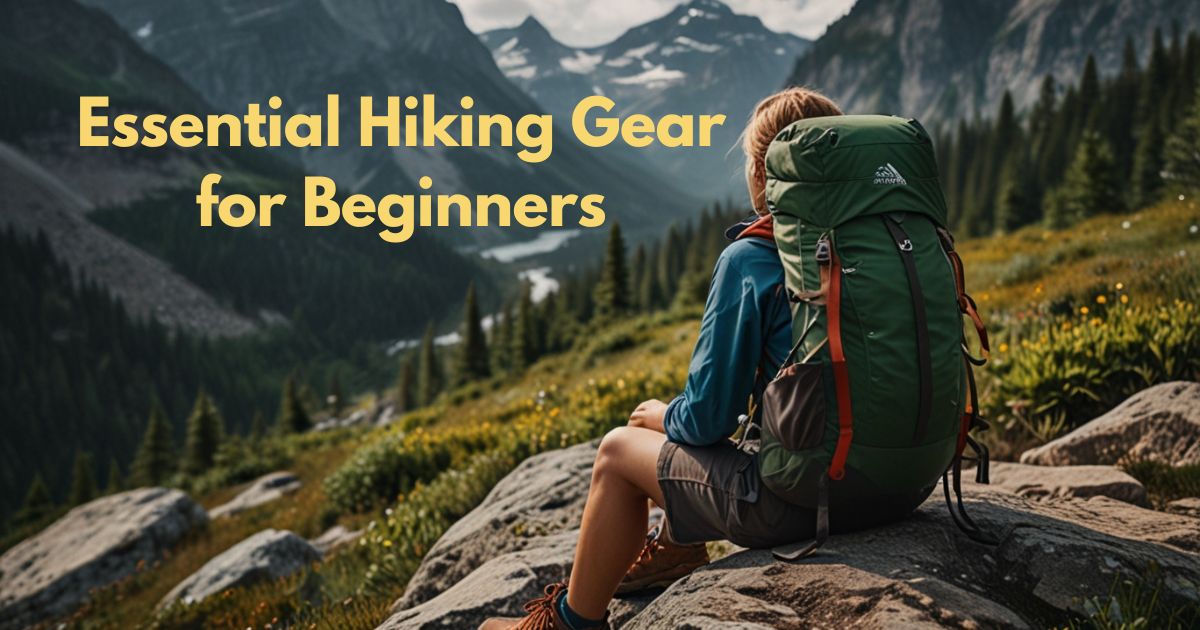Hiking is a fantastic way to connect with nature, get some fresh air, and enjoy physical activity. However, for beginners, it can be overwhelming to figure out exactly what gear is necessary to have a safe and enjoyable experience. The right equipment not only makes the adventure more comfortable but also ensures your safety. Whether you’re going on a short local hike or planning to explore a more challenging trail, having the right gear is essential. In this article, we’ll guide you through the basic hiking gear you need as a beginner.

1. Footwear: The Foundation of a Good Hike
Hiking Boots vs. Trail Shoes
The most critical piece of hiking gear is footwear. A good pair of hiking boots or trail shoes will keep your feet comfortable and protected. Beginners should invest in sturdy, well-fitted boots that offer good ankle support, especially if they’re hiking on rocky or uneven terrain. Trail shoes can be an alternative for well-maintained, flatter trails, as they’re lighter and more flexible.
Look for features such as waterproofing, breathability, and a strong grip in both boots and trail shoes. A waterproof material will help keep your feet dry in wet conditions, while breathable fabrics will prevent your feet from overheating.
Socks Matter Too
Don’t overlook your socks. Choose moisture-wicking, quick-drying materials like merino wool or synthetic blends. These materials help prevent blisters, which can ruin a hike, especially for beginners.
2. Clothing: Dress for Comfort and Safety
Layering Your Clothing
When it comes to clothing, layering is key. The weather can change quickly when you’re hiking, especially at higher elevations, so wearing multiple layers allows you to adjust your outfit as needed.
- Base Layer: Start with a moisture-wicking base layer, which will keep sweat away from your skin and help regulate your body temperature. Avoid cotton, as it retains moisture and can leave you feeling cold and uncomfortable.
- Insulating Layer: The next layer should provide insulation. A fleece or down jacket is a good choice to keep you warm on colder hikes.
- Outer Layer: Your outer layer should protect you from the elements. Look for a lightweight, waterproof, and windproof jacket to shield you from rain and wind.
Hats and Gloves
A wide-brimmed hat can protect your face and neck from the sun, while a warm beanie and gloves can be essential for colder hikes. Even in mild weather, it’s a good idea to bring along a light hat and gloves in case temperatures drop unexpectedly.
3. Backpack: Carry Your Essentials Comfortably
A well-fitting hiking backpack is essential for carrying all your gear. For beginners, a daypack that holds 20-30 liters should be sufficient for short hikes. Make sure the backpack is comfortable, with padded shoulder straps and a waist belt to help distribute the weight evenly.
Key Items to Pack
- Water: Hydration is critical on any hike. A hydration system (such as a bladder with a tube) or water bottles should be easy to access, and you should carry enough water to last the entire hike. For longer hikes, consider a water filtration system or tablets.
- Snacks: Bring lightweight, high-energy snacks like trail mix, energy bars, or dried fruit to keep your energy levels up.
- First Aid Kit: A basic first aid kit with band-aids, antiseptic wipes, and blister treatment is crucial. You never know when you might need it.
- Navigation Tools: Even on a well-marked trail, having a map and compass or GPS device is essential. Beginners should learn how to read maps and use a compass, as phone batteries can die, and signals can be unreliable in remote areas.
4. Safety Gear: Be Prepared for the Unexpected
Navigation Tools
As mentioned above, maps and compasses are must-have items. While it’s tempting to rely on your smartphone’s GPS, it’s important to have a backup in case your phone runs out of battery or loses signal. Learning basic navigation skills is a great investment for beginners.
Emergency Gear
It’s always wise to be prepared for unexpected situations. Beginners should carry a few pieces of emergency gear:
- Headlamp or flashlight: In case you find yourself hiking later than expected or in poor lighting conditions, a headlamp or flashlight with extra batteries is essential.
- Whistle: A whistle can help you signal for help if you get lost or injured.
- Emergency blanket: These lightweight, foil-like blankets are small and easy to pack, and they can help retain body heat if you’re caught in cold weather.
- Multitool or knife: A small, versatile tool can be handy for quick fixes or emergencies.
5. Trekking Poles: Added Stability and Support
Trekking poles are a great addition for beginners, especially if you’re hiking on uneven terrain or climbing hills. They provide extra stability, reduce the strain on your knees, and help with balance. Adjustable trekking poles are ideal as you can shorten them for ascents and lengthen them for descents.
6. Sun Protection: Shield Yourself from the Elements
No matter the weather, it’s essential to protect yourself from the sun’s harmful rays. Pack a high-SPF sunscreen and reapply it regularly, even on cloudy days. Sunglasses with UV protection are also a must to shield your eyes. Lip balm with SPF is another small but important item to bring along to avoid dry, cracked lips from sun or wind exposure.
7. Hydration: Staying Properly Hydrated
Staying hydrated is critical for any hiker, but beginners may not realize just how much water they need to carry. As a general rule, you should aim to drink about half a liter of water for every hour of hiking, depending on the difficulty of the trail and the temperature. On hot days or challenging hikes, you may need even more. Many hiking backpacks are designed to accommodate a hydration reservoir, which makes it easy to drink water on the go.
For longer hikes, consider bringing a portable water filter or purification tablets so you can safely drink from natural water sources.
8. Other Essential Gear: The Must-Have Items for Beginners
Multi-Tool or Pocket Knife
A multi-tool or pocket knife is a small yet versatile tool that can be useful in a variety of situations, from fixing gear to preparing food. While you may not need it on every hike, it’s a good idea to keep one in your pack just in case.
Camera or Smartphone
Don’t forget to capture the beauty of your hike! Whether you’re carrying a dedicated camera or using your smartphone, taking photos is a great way to document your adventures and share them with friends.
9. Optional Gear: Extras for Enhanced Comfort
While the above items cover the basic essentials, there are a few optional extras that can enhance your hiking experience:
- Sitting pad: If you plan on taking breaks, a small sitting pad can provide comfort when resting on rocky or wet ground.
- Gaiters: If you’re hiking in muddy or wet conditions, gaiters can help keep your feet dry and clean by covering the tops of your boots and lower legs.
Conclusion
For beginners, choosing the right hiking gear is crucial for ensuring a safe and enjoyable experience. From sturdy footwear and layered clothing to essential safety tools like navigation equipment and first aid kits, the right gear makes all the difference. Remember, the best way to determine what works for you is to start small, test your gear on shorter hikes, and adjust your setup based on your needs and preferences.
With this guide to basic hiking gear, you’re well on your way to embarking on your first hiking adventure!










